S-comma
S-comma (majuscule: Ș, minuscule: ș) is a letter which is part of the Romanian alphabet, used to represent the sound /ʃ/, the voiceless postalveolar fricative (like sh in shoe).

History

The letter was proposed in the Buda Lexicon, a book published in 1825, which included two texts by Petru Maior, Orthographia romana sive latino-valachica una cum clavi and Dialogu pentru inceputul linbei române, introducing ș for /ʃ/ and ț for /ts/.[1]
Unicode support
This letter however was not initially supported in early Unicode versions, nor in the predecessors like ISO/IEC 8859-2 and Windows-1250. Instead, Ş (S-cedilla) was used for digital texts written in Romanian, a convention that still exists today. In some contexts, like with low-resolution screens and printouts, the visual distinction between ș and ş is minimal.
S-comma was later introduced in Unicode 3.0 at the request of the Romanian national standardization body. Computers with Microsoft operating systems older than Windows XP do not have compatible fonts. Encoding for the S-comma was not supported in retail versions of Windows XP, but the European Union Expansion Font Update from Microsoft provides the feature. Because of issues with accessibility and convenience, almost all modern Romanian texts still use S-cedilla (or even S), despite recommendations to migrate from cedilla to comma.
The letter is part of Unicode's Latin Extended-B range, under "Additions for Romanian", titled as "Latin capital letter S with comma below" (U+0218) and "Latin small letter s with comma below" (U+0219).[2] In HTML, these can be encoded by Ș and ș, respectively.
Use of the comma with the letter S
Ș ș | |||||||||||||||||||||||||||||||||||||||||||||||||||||||||||
|---|---|---|---|---|---|---|---|---|---|---|---|---|---|---|---|---|---|---|---|---|---|---|---|---|---|---|---|---|---|---|---|---|---|---|---|---|---|---|---|---|---|---|---|---|---|---|---|---|---|---|---|---|---|---|---|---|---|---|---|
| S-comma | |||||||||||||||||||||||||||||||||||||||||||||||||||||||||||
| |||||||||||||||||||||||||||||||||||||||||||||||||||||||||||
- Romanian
- The Romanian letter Ș/ș (S with comma) represents the voiceless postalveolar fricative /ʃ/ (as in "show"). On outdated systems which do not support the glyph, the symbol Ş/ş (S with cedilla) is used. Example word: Timișoara.
Character encoding
| Character | Ș | ș | ||
|---|---|---|---|---|
| Unicode name | LATIN CAPITAL LETTER S WITH COMMA BELOW | LATIN SMALL LETTER S WITH COMMA BELOW | ||
| Encodings | decimal | hex | decimal | hex |
| Unicode | 536 | U+0218 | 537 | U+0219 |
| UTF-8 | 200 152 | C8 98 | 200 153 | C8 99 |
| Numeric character reference | Ș | Ș | ș | ș |
See also
References
- Marinella Lörinczi Angioni, "Coscienza nazionale romanza e ortografia: il romeno tra alfabeto cirillico e alfabeto latino ", La Ricerca Folklorica, No. 5, La scrittura: funzioni e ideologie. (Apr., 1982), pp. 75–85.
- Unicode code charts. Latin Extended-B: Range 0180–024F